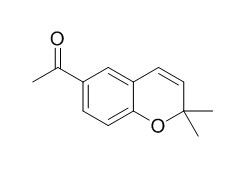Demethoxyencecalin
Reference standards.
Inquire / Order:
manager@chemfaces.com
Technical Inquiries:
service@chemfaces.com
Tel:
+86-27-84237783
Fax:
+86-27-84254680
Address:
1 Building, No. 83, CheCheng Rd., Wuhan Economic and Technological Development Zone, Wuhan, Hubei 430056, PRC
Providing storage is as stated on the product vial and the vial is kept tightly sealed, the product can be stored for up to
24 months(2-8C).
Wherever possible, you should prepare and use solutions on the same day. However, if you need to make up stock solutions in advance, we recommend that you store the solution as aliquots in tightly sealed vials at -20C. Generally, these will be useable for up to two weeks. Before use, and prior to opening the vial we recommend that you allow your product to equilibrate to room temperature for at least 1 hour.
Need more advice on solubility, usage and handling? Please email to: service@chemfaces.com
The packaging of the product may have turned upside down during transportation, resulting in the natural compounds adhering to the neck or cap of the vial. take the vial out of its packaging and gently shake to let the compounds fall to the bottom of the vial. for liquid products, centrifuge at 200-500 RPM to gather the liquid at the bottom of the vial. try to avoid loss or contamination during handling.
Int J Biol Macromol.2020, 161:1230-1239.
J Med Food.2021, 24(3):209-217.
Current Traditional Medicine, 2021, 7:326-335(10).
Nutrients.2019, 11(6):E1380
Molecules.2024, 29(5):1048.
Enzyme Microb Technol.2022, 161:110111.
J.Soc.Cosmet.Sci.Korea2024, 50(3): 261-270
National University of Pharmacy2022, 1:73-76
Front Pharmacol.2018, 9:756
Acta Biochim Pol.2015, 62(2):253-8
Related and Featured Products
J Chem Ecol. 2007 Dec;33(12):2245-53.
Antifungal activity of a new phenolic compound from capitulum of a head rot-resistant sunflower genotype.[Pubmed:
18034282]
METHODS AND RESULTS:
In a previous study, we observed that bract and corolla extracts from a Sclerotinia sclerotiorum-resistant sunflower contained high amounts of the known coumarins scopoletin, scopolin, and ayapin. There was a correlation between coumarin concentration and disease resistance. Thin layer chromatography showed higher concentrations of three other compounds in the resistant genotype when compared to the susceptible.
CONCLUSIONS:
A bioassay-directed purification that used column chromatography and HPLC allowed the isolation of a new compound, 3-acetyl-4-acetoxyacetophenone, and known compounds, Demethoxyencecalin and 3-acetyl-4-hydroxyacetophenone.
Planta Med. 1987 Oct;53(5):488-92.
Accumulation and Biotransformation of Chromenes and Benzofurans in a Cell Suspension Culture of Ageratina adenophora.[Pubmed:
17269074]
A cell suspension culture of AGERATINA ADENOPHORA was shown to yield several novel chromene and benzofuran derivatives in minute amounts that were different to the compounds found in seedlings of the same species. The structure elucidation of the new compounds is described.
METHODS AND RESULTS:
When two of the seedling chromenes (Demethoxyencecalin and demethylencecalin) were fed to the cell suspension culture, one biotransformation product each was obtained in high yields (80%) that originated from a hydroxylation at one of the geminal methyl groups of the chromene heterocycle. These products accumulated largely in the growth media even though the presence of cells was necessary for the biotransformations to occur. When the third seedling chromene (encecalin) was fed to the cell auspension culture, no significant biotransformation was noted but several of the benzofurans present as cell culture metabolites showed a significantly increased accumulation in the growth media of the treated cultures.
CONCLUSIONS:
This increased accumulation of benzofurans was found to be inducible also by adding yeast extract to the cell culture. The metabolism of chromenes and bezofurans in the cell suspension culture is discussed.
Planta Med. 1986 Oct;(5):349-51.
[Demethoxyencecalin and Thymol derivatives from Arnica sachalinensis1.].[Pubmed:
17345336]
METHODS AND RESULTS:
From the flowers of ARNICA SACHALINENSIS the chromene Demethoxyencecalin , 10-acetoxy-8,9-epoxy-3- O-isobutyrylthymol, and 10-acetoxy-8-hydroxy-9-isobutyryloxythymol were isolated and their structures established by mass spectrometry (13)C-, and (1)H-NMR spectroscopy.



